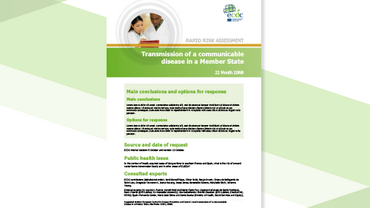Rapid risk assessment: Microcephaly in Brazil potentially linked to the Zika virus epidemic, 25 November 2015
The increase in congenital microcephaly observed in Brazil is of concern. Its emergence a few months after the introduction of Zika virus (ZIKV) infection into the country raises questions about the possible role of the infection in congenital microcephaly.
There is currently only ecological evidence of an association between the two events. A possible causative nature of the association cannot be ruled out with the evidence available. Further investigations and studies will contribute to a better characterisation of the association, and provide a better understanding of the possible role of other prenatal infections, genetic risk factors, environmental exposure to chemicals or consumption of of teratogenic drugs. Studies of the ZIKV genome will provide information on possible changes that might influence ZIKV disease characteristics and vector competence.
Executive Summary
This risk assessment evaluates the possible link between the observed increase of congenital microcephaly in Brazil and Zika virus (ZIKV) infection and assesses the potential risks associated with ZIKV infection for travellers, the EU, and the EU Overseas Countries and Territories and Outermost Regions.
There is currently only ecological evidence of an association between the two events, while a possible causative association cannot be ruled out; further investigations and studies are needed to understand the association and the possible role of other factors, states the ECDC risk assessment.
In November the Brazilian Ministry of Health declared a public health emergency in relation to an unusual increase in the number of children born with microcephaly in 2015.
The north-Brazilian state of Pernambuco has reported 141 cases of microcephaly in newborns in 2015, in comparison to an average of 10 cases per year from 2010–2014. A ten-fold increase in the incidence of microcephaly among newborns was observed in other north-eastern Brazilian states.
As the increase is within nine months of the Zika emergence, the Ministry of Health of Brazil has suggested a possible relationship between the increase in microcephaly and the ongoing Zika outbreak. While investigations are still ongoing, the authorities issued specific recommendations for pregnant women relating to protection from mosquito bites: such as keeping doors and windows closed or screened, wearing trousers and long-sleeved shirts and using repellents.
In comparison, in French Polynesia there was an increase of central nervous system malformations in foetuses and newborns following an epidemic of ZIKV infection: at least 17 such cases were reported during 2014–2015, coinciding with the Zika outbreaks on the French Polynesian islands, four tested women were found positive for flavivirus.
Congenital microcephaly is a descriptive diagnosis for a neurodevelopmental disorder causing small head of the newborn. It can be caused by a variety of factors, such as genetic disorder, brain injury, consumption of teratogenic drugs, exposure to chemicals as well as transplacental infections.
The involvement of ZIKV in microcephaly is not documented in the scientific literature, however, other Flavivirus infections are known to have the potential to cause premature birth, congenital defects and microcephaly.
This risk assessment states that:
- Travellers to countries where ZIKV is circulating are at risk of getting the disease through mosquito bites.
- During the winter season the risk for transmission of Zika is extremely low in the EU as the climatic conditions are not suitable for the activity of mosquito vector species.
- As the Zika epidemic is currently spreading in South America, the introduction of the virus from Brazil, Colombia, and Suriname or from Cape Verde to EU Overseas Countries and Territories and EU Outermost Regions, especially in the vicinity is possible.
The risk assessment lists risk mitigation options for public health authorities in the EU/EEA, including precautions that are advisable to travellers to affected areas, particularly pregnant women.
Zika virus disease is a mosquito-borne viral disease which can be transmitted by invasive mosquito species, such as Aedes aegypti and Aedes albopictus. The disease symptoms, i.e. fever, joint swelling, rash, headaches, are usually mild and last for 2 to 7 days.







